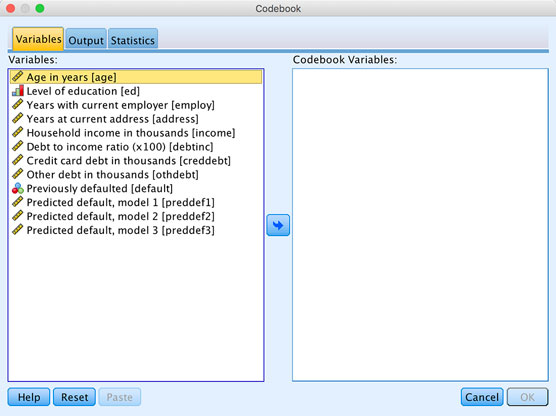Most data files contain many variables and it's not always easy to remember the properties of each one. You may want to produce documentation, often referred to as a codebook, listing all the information about the variables in the data. SPSS provides the Codebook procedure for viewing variable attributes and reporting summary descriptive tables for each variable.
To create a Codebook, choose Analyze→Reports→Codebook, as shown.
 Choosing the Codebook procedure.
Choosing the Codebook procedure.The following figure shows the Codebook dialog. You’ll need to select the variables of interest and then run the analysis from the procedure dialog. Most procedure dialogs have the same basic components and contain a number of common features.
 The Codebook dialog.
The Codebook dialog.Each procedure dialog contains the following components:
- Source variables are variables available for the procedure.
- Target variables are variables used in the procedure. You’ll need to move the source variable(s) to the target variables box
- Control buttons run, reset, or cancel the procedure.
- Dialog tabs or buttons control optional specifications.
You can resize any SPSS dialog. If you make it larger, it's easier to see the variable list. In addition, right-click any variable in the source list to display a description of that variable. And if you are having trouble finding a variable in the source list, in most dialogs, you can type the first letter of the label to display matching variable labels. Repeatedly typing the letter will allow you to move through the list to each variable label beginning with that letter. If you're a fast typist, you can include multiple letters to better narrow your search for variables.
The icons displayed next to variables in the dialog provide information about the variable type and measurement level.
Because SPSS procedures provide a great deal of flexibility, the dialog often can't display all possible choices. The main dialog contains the minimum information required to run the procedure. You can make additional optional specifications in subdialogs. The subdialogs are accessed from the buttons located on the right side of the main dialog or tabs at the top of the dialog.The name of subdialog if often similar to the name of the equivalent subcommands in SPSS Syntax.
Instead of an OK button, subdialogs have a Continue button, to return to the main dialog. The control buttons that appear along the bottom of the dialog instruct SPSS to perform an action:- OK runs the procedure. The OK button is disabled (appears dimmed) until the minimum dialog requirements are completed.
- Reset resets all specifications made in the dialog and associated subdialogs and keeps the dialog open.
- Cancel cancels the selections and closes the dialog without running the procedure.
- Help opens the SPSS Help facility with help relevant to the current dialog.
- Paste: Pastes SPSS syntax for commands into the Syntax Editor window.
- In the Variables box, click the first variable, hold down the shift key, and click the last variable.
- Click the arrow to move all the variables to the Codebook Variables box, as shown.
 The completed Codebook dialog.
The completed Codebook dialog. - Click OK to run the analysis.





